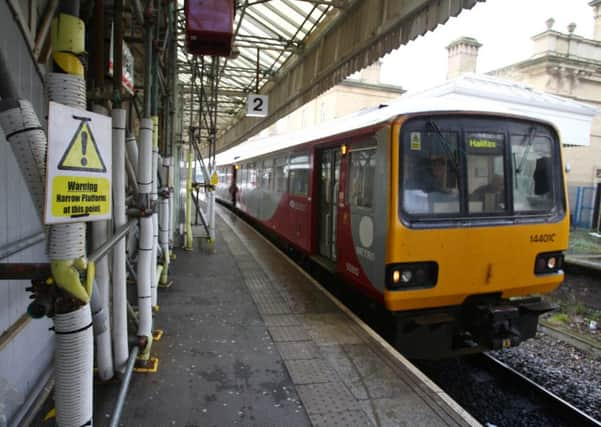Work on Calder Valley line to start in new year


The Department for Transport says linespeed and capacity work will start in January 2016 – but the scope of work is not yet clear, says campaigning group HADRAG (Halifax and District Rail Action Group).
And HADRAG has notes that an electrification programme is to be considered for 2019-24 but says it is “ridiculous question should have to be asked” about electrifying the Calder Valley Line.
Advertisement
Hide AdAdvertisement
Hide AdAfter pressing Patrick McLoughlin MP, the Secretary of State for Transport, and rail infrastructure body Network Rail over the summer, HADRAG has received a letter from the Department for Transport which states that work on capacity and speed improvements on the Calder Valley Line will start in January 2016.
The letter also confirms that Network Rail will consider the case for electrifying the Calder Valley Line as it updates its national electrification strategy for 2019-24.
The news was also announced by rail minister Andrew Jones MP in a written answer to a parliamentary question put by Halifax MP Holly Lynch.
HADRAG welcomes the announcement, but has written back to the Secretary of State for Transport Patrick McLoughlin MP asking for clarification of the scope of the work actually starting in the New Year.
Advertisement
Hide AdAdvertisement
Hide AdHADRAG says that work planned for Network Rail’s 2014-19 five-year plan included:
l increased line speed from Manchester through Hebden Bridge and Halifax to Bradford - it is understood that current maximum speed of limits of 70mph or less could be increased to maybe 85mph, allowing journey times to be significantly shortened.
l upgraded signalling to give capacity for a more frequent and reliable train service - current signalling particularly between Hebden Bridge and Bradford restricts frequency and affects punctuality as if one train is late the one behind it also gets delayed.
l and remodelling of Milner Royd Junction at Sowerby Bridge for higher speed - this is the point where the rail routes from upper Calderdale to Halifax and to Brighouse diverge and is a “pinch point” in the network; a faster junction would not only reduce journey times but also reduce delays due to trains on one route waiting for the other.
Advertisement
Hide AdAdvertisement
Hide AdIt is understood that the Calder Valley improvements are required prior to electrification of the so-called “North Transpennine” Huddersfield Line to provide capacity for diversions during the electrification work.
The NTP electrification project was “paused” last June as Network Rail struggled to deliver projects in its 2014-19 control period known as “CP5”, but then restarted by the Secretary of State at the end of September. Huddersfield Line electrification will begin in earnest after a two-year intermission for replanning and is expected to be completed by 2022, four years later than originally predicted. The hope is that the replanning will result in a better project with more new capacity which, HADRAG hopes, could also benefit Calder Valley Line services for example by allowing more trains through Brighouse.
Sir Peter Hendy, the new chairman of Network Rail, is understood to be reviewing all “CP5” projects – which is why there was concern about the proposed Calder Valley enhancements.
Stephen Waring, hairman of HADRAG said: “It is good news that after literally years of waiting work is about to start on modernising the track and signals on our line. But the announcement is slightly lacking in detail and we have written back to the Government asking for clarification.
Advertisement
Hide AdAdvertisement
Hide Ad“We need to know that the whole project is going ahead with speed and capacity improvements all the way from Manchester to Bradford
“On Calder Valley line electrification it is ridiculous that the question has to be asked on this. Our line was ranked top by the Northern Electrification Task Force earlier this year and put in a list of lines recommended for the 2019 to 2024 five year plan.
“ It makes complete sense.”